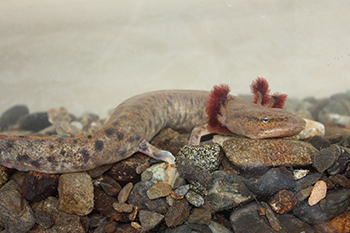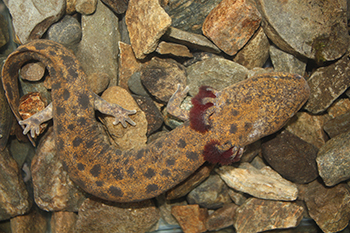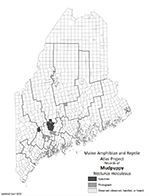Home → Fish & Wildlife → Wildlife → Species Information → Reptiles & Amphibians → Mudpuppy
Mudpuppy
Necturus maculosus - Invasive Species
On this page:

Photo: Trevor Persons
Distinguishing Characteristics

Photo: Trevor Persons
- Very large, approximately 8 to 12 inches in length
- Fully aquatic, with large, permanent, dark red bushy external gills
- Brownish color overall with black spots or blotches
- Flat head, small eyes, powerful flattened tail
Status and Distribution in Maine
- Uncommon
- Exotic (non-native)
- Central region
Habitat
- Fully aquatic, uses lakes, marshes, drainage ditches, and streams
- In Maine, only known from lakes and large ponds
Diet
- Eats insects and crayfish, sometimes also fish and fish eggs
Seasonal Changes
- Active year-round; sometimes caught by people ice-fishing
Natural History Notes
- Accidentally introduced into Great Pond (Belgrade Lakes) around 1940; may have spread to other sites from use as fishing bait
- Mates and lays eggs in spring; eggs attached to underside of rocks or logs on lake bottom
Share Your Sighting
There is much still to learn about the distribution and ecology of Maine’s herpetofauna, and we encourage members of the public to share their photo-documented observations as part of the Maine Amphibian & Reptile Atlas Project (MARAP).
To see if a township still needs documentation of a species, consult this distribution map (PDF). If a township lacks a photo or specimen record, we want your observation!
There are two ways to share your observations:
Submit your reptile or amphibian observation online
No service? No problem. Click here to download the survey to your device while connected, then take offline to collect observations from anywhere. Tip: The survey works best on Google Chrome and Safari.
Or upload sightings to the iNaturalist citizen science project through their website at iNaturalist.org or mobile app.
- When submitting an observation through iNaturalist add a description of the location (and other noteworthy information) to the “notes” field. This serves as a check on the locations automatically generated by smartphone cameras, which may be imprecise if cell service or GPS coverage is weak.
Thank you for doing your part to help conserve Maine’s reptiles and amphibians.
